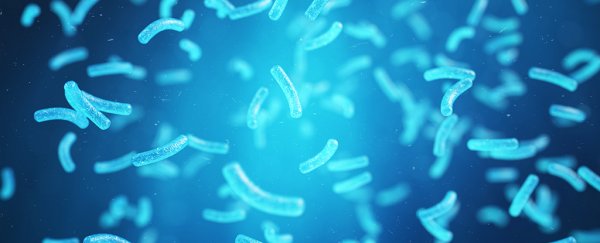Bacteria deep in our intestines are capable of producing electricity, a new study has discovered, and researchers have also worked out how these single-celled organisms do it – by breaking down sugar as part of their metabolic processes.
Not only could that help us understand more about how our own digestive system works, it might also help in the development of living batteries which could use bacteria as a power source instead of the more traditional options.
In this case, researchers looked at the lactic acid bacterium Enterococcus faecalis, a bug found in healthy humans (and animals) but also responsible for meningitis, urinary tract infections and other health issues.
Now we know it has some additional powers.
"Lactic acid bacteria, and many other bacteria, are probably capable of performing electrochemistry," says one of the team, microbiologist Lars Hederstedt from Lund University in Sweden.
The process E. faecalis is using is extracellular electron transport (EET), a way of swapping electrons in and out of the immediate environment – a bit like the way we breathe air. In this way, bacterial cells are able to produce an electric current and the energy to live.
Electricity generation has been seen before in bacteria, but now we know it's going on in our inner plumbing as well, in small amounts.
In experiments, the researchers saw E. faecalis cells placed on an electrode generating current through breaking down sugar. Electron transmission was aided by molecules known as quinone molecules.
The research also hints at ways in which the bacteria cooperates with other microorganisms in the wild, combining metabolic forces with fellow bacteria and fungi to make up for gaps in its own capabilities – a process known as synthrophy.
"Synthrophy provides a metabolic ability that the cells do not have on their own," says Hederstedt. "For example, a certain chemical compound can be effectively broken down in nature only when two different types of bacteria occur together, but not individually."
Learning more about E. faecalis could potentially lead to better treatments – the infections caused by the bacteria can be difficult to treat with current antibiotics, and it has been linked with certain types of colon cancer, too.
The research is being published at almost the same time as another study looking a EET-capable bacteria in the human gut. A team from the University of California, Berkeley found a variety of bacteria, including E. faecalis, producing currents inside the body.
The UC Berkeley researchers think the EET technique has been developed to help bacteria survive in both oxygen-rich and oxygen-poor environments. It's a bit like a backup system.
We haven't seen bacteria producing electricity inside the human body before, and scientists are still exploring how EET works with these microorganisms – it opens up a lot of research opportunities for the gut microbiome, antibiotics, new treatments, and bacteria living inside and outside of animals.
"We believe our results encourage more research into environments with a complex composition of organisms," says Hederstedt.
The research has been published in Biochemistry.
